Having thought about trying out macro photography for a while, I checked a few options to be able to focus closer, without purchasing a dedicated macro lens.
Extension tubes are cheap and an interesting solution, but I wanted much greater magnification that a tube can offer, and also to go over 1:1 as dedicated macro lenses offer.
In the tradition of Tripod Kicks, it should be cheap, too!!
A few minutes of eBay browsing came up with a two part solution, to join together a 1-dimension Focusing Rail and a Macro Bellows unit. Additional searching showed that the cheap sellers were probably just getting their units from the same manufacturer, so I went for for the cheapest.
The Focusing Rail is from ebay seller Go4DC Photo Supplies. It cost €21 with free shipping.

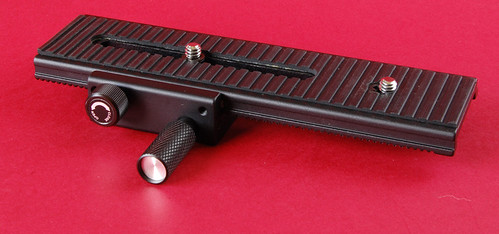
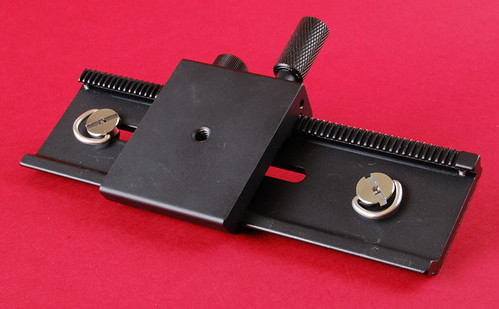
It is all metal, with rubber on top. The large knob adjusts the position of the rail, and the small knob secures it into place. There are two captive 1/4'’ screws, with convenient hoops to tighten by hand. The bottom plate is just a single 1/4’’ threaded hole.

I intended to use this as part of an Arca-Swiss compatible system, so I took the old plate from my Phottix KB-1 Ball Head, and screwed it into place with a big spare 1/4''-20 T-Screw that I got from SunwayPhoto.
The next step was the Macro Extension Bellows, from eBay seller Hong Kong Supplies. It cost €24.50, free shipping.

It is mostly metal, and the bellows itself appears to be plastic. There is a single threaded 1/4’’ hole at the bottom of the back plate.
Unfortunately, the camera end does not rotate, so only a landscape position is possible.
The wider knob moves the geared front plate back and forth, and the smaller knob locks it into place. There is a button to unlock the lens, and that’s it.
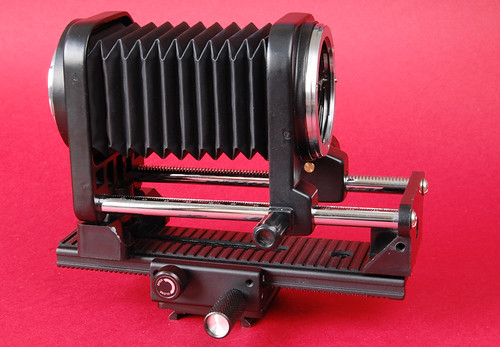
I proceeded to attach the bellows and focusing rail, and soon discovered that I couldn't fit my Nikon D40 to the back plate when attached to the focusing rail, because it bumps into the protruding end of the rail. So I had to attach the camera first, and then screw the bellows into the rail.
After assembly of all items, it was time to test it!
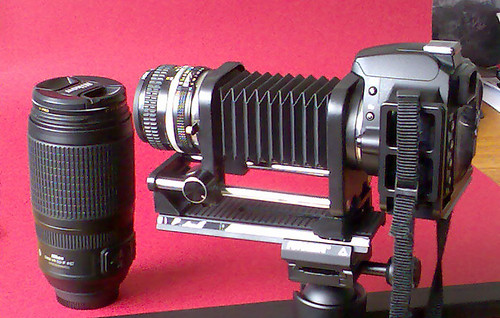
I attached my D40 and the Nikkor 50mm 1.4 AI-S to the macro system, and tried to get a large magnification.
The system is very simple to use:
1. Set the lens to maximum aperture (so you can see through the viewfinder).
2. Set the focus ring to infinity (or just about anywhere, really)
3. To change magnification ratio, move the bellows to change the distance from the body to the lens. The farther it is, the greater the magnification.
4. To focus, move the focusing rail, effectively bringing everything closer or farther from the subject.
5. Set the aperture to the desired value, and shoot.
6. Check histogram, correct shutter, ISO or aperture, repeat.
Using the setup above, I managed to get this picture. It's the lettering on a B+W 67mm 010 MRC UV filter, from my recommended provider of cheap genuine Hoya and B+W filters: MaxSaver.
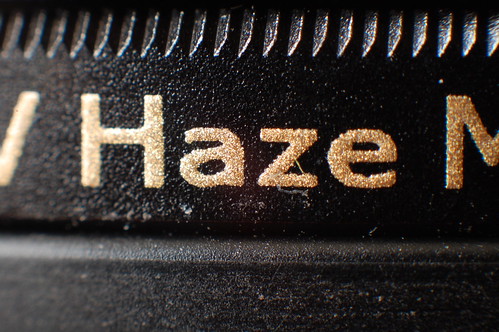
Tech details: D40 @ ISO200 / 1/2shutter ; 50mm 1.4 AI-S @ f/11The real size of this detail is about 1cm wide. Given that the D40 DX sensor is 2.37cm wide, that comes out as a 2.37:1 magnification ratio.
Over 2x life size, that’s pretty good!Depth of field is a huge challenge here, probably less than a millimeter at f/11.
Additional techniques will be needed for usable images, like focus stacking in post production (click for a quick tutorial).Interestingly, reversing the lens (with a BR2A ring) will give you the same magnification, but with increased working distance (about 6cm instead of 2cm). The problem is that now the back glass element is exposed, with no filter to protect it...

For reference. this is the same subject, but using the 18-55 kit lens at 55mm, and closest focusing distance. Quite a difference.




Brilliant post. Thank you.
ReplyDeleteJust an update. I bought mine and also found the camera won't fit on without taking it apart. However, an old extension tube will sort that out.
ReplyDelete